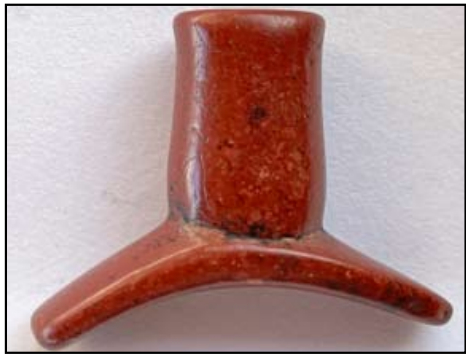|
A Catlinite Hopewell Platform Pipe
|
by Dr. Sandy B. Carter, Jr. |
| Central States Archaeological Societies 2024
January Journal |
Big Canoe, Georgia |
|
This excerpt from "A Catlinite Hopewell
Platform Pipe" published
in the 2024 Central States Archaeological Societies 2024
January Journal
Read this and mores in the Central
States Archaeological 2024
January Journal which can be purchased on-line after March
2025
|
 |
|
Figure 1. Catlinite pipestone Hopewell platform
pipe, Kankakee County, Illinois. Curation and photography by author
|
|
For over 40 years I have admired Hopewell platform pipes and the polished
pipestone materials they are made of, with colors including green/gray, reddish
gray, cream to tan and red. The red pipes are the most eye catching to me,
and I am proud to be the curator of the catlinite pipe shown in Figure 1.
The pipe was found in Kankakee County, Illinoiis, south of Chicago’s
Cook County in northeastern Illinois. Bill Brockman obtained it in the 1960s
from Hubert C. Wachtell, the editor of the first two editions of Who’s
Who in Indian Relics (1960 and 1968). I subsequently acquired the pipe from
Brockman. It is small at 1 ?” (W) x 1 ½” (H), and the
tubular bowl is encircled by three incised horizontal undulating lines (~~~~~~~~),
similar to one of the 17 catlinite pipes found at Tremper Mound with incised “zigzag
lines” (Ref. 1, p. 201). This pipe dates to approximately 50 BC and
is a transition between V-based platform pipes (150 BC- 50 BC, Fig. 2) and
classic curved-base monitor platform pipes (50 BC- AD 300, Fig. 3, Ref. 2,
p. 700).
Hopewell pipes were infrequently made of catlinite pipestone. Farnsworth,
et al. in a study of 169 Illinois region pipes (includes Illinois counties
and eastern Iowa and southwestern Indiana counties) noted only 5% were made
of catlinite (Ref. 2, p. 703). In contrast, 55% of Illinois region pipes
were made from gray Sterling pipestone (originating from the Sterling quarry
in northwest Illinois in the Illinois River valley on the lower portion of
the Rock River), 34% were made from local limestones, claystones, dolomites
and shale (Ref. 2, pp. 701 and 705), and no Illinois Hopewell pipes were
made of Ohio Feurt Hill pipestone (Ref. 4, p.198).
In the Ohio Valley where the Hopewell culture was 100 years later in appearing
than in the Illinois Valley, platform pipe caches infrequently include ...
Read other great columns in the Central States Archaeological Societies 2024
January Journal which can be purchased on-line after March 2024
|
|




